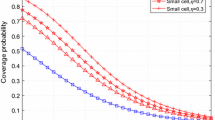Abstract
On the basic of traditional macro cellular networks, ultra dense networks deploy plenty of low-power nodes working with maximum power, which provide superior communication quality and produce more energy consumption in networks. Aiming at the problem of wasting network resources caused by low-power nodes during low-load period in ultra dense networks, we study a kind of base station sleeping mechanism based on user connections. When the network loads are low, the connections between users and base stations (BSs) are sensed by environment awareness technology. Then, the connection relationship is used to establish a connection matrix. After that we use the established connection matrix to build a weighted bipartite graph. Taking the users’ QoS and the load of BSs into account, we build a weight matrix by weighting the two as the weights of the bipartite graph. We get the optimal connection between users and base stations by constantly optimizing the value of the connection matrix. By modeling, we transform the optimization problem into a 0–1 integer programming problem and get the optimal connection by Particle Swarm Optimization algorithm. Finally, the sleeping mechanism is executed according to this connection matrix, and we achieve the goal of energy conservation by closing low-load BSs.










Similar content being viewed by others
References
Yang, Z. X., & Niu, Z. S. (2013). Energy saving in cellular networks by dynamic RS-BS association and BS switching. IEEE Transactions on Vehicular Technology, 62(9), 4602–4614.
Bogucka, H., & Conti, A. (2011). Degrees of freedom for energy savings in practical adaptive wireless systems. IEEE Communications Magazine, 49(6), 38–45.
Liu, C., Natarajan, B., & Xia, H. X. (2016). Small cell base station sleep strategies for energy efficiency. IEEE Transactions on Vehicular Technology, 65(3), 1652–1661.
Lorincz, J., Garma, T., & Petrovic, G. (2012). Measurements and modelling of base station power consumption under real traffic loads. Sensors, 12(4), 4281–4310.
Du, J. B., Zhao, L. Q., Feng, J., et al. (2016). Enhanced PSO based energy-efficient resource allocation and CQI based MCS selection in LTE-A heterogeneous system. China Communications, 13(11), 197–204.
Soh, Y. S., Quek, T. Q. S., Kountouris, M., et al. (2013). Energy efficient heterogeneous cellular networks. IEEE Journal on Selected Areas in Communications, 31(5), 840–850.
Samdanis, K., Taleb, T., Kutscher, D., et al. (2012). Self organized network management functions for energy efficient cellular urban infrastructures. Mobile Networks and Applications, 17(1), 119–131.
Jia, C. L., & Lim, T. J. (2015). Resource partitioning and user association with sleep-mode base stations in heterogeneous cellular networks. IEEE Transactions on Wireless Communications, 14(7), 3780–3793.
Haddar, B., Khemakhem, M., et al. (2016). A quantum particle swarm optimization for the 0-1 generalized knapsack sharing problem. Natural Computing, 15(1), 153–164.
Hutter, H. P., Moshammer, H., et al. (2006). Subjective symptom, sleeping problems, and cognitive performance in subjects living near mobile phone base stations. Occupational and Environmental Medicine, 63(5), 307–313.
Author information
Authors and Affiliations
Corresponding author
Additional information
Publisher's Note
Springer Nature remains neutral with regard to jurisdictional claims in published maps and institutional affiliations.
Rights and permissions
About this article
Cite this article
Yu, Y., Kong, F. & Chen, D. Research on Base Station Sleeping Mechanism of User Connections in Ultra Dense Network. Wireless Pers Commun 102, 79–93 (2018). https://doi.org/10.1007/s11277-018-5828-9
Published:
Issue Date:
DOI: https://doi.org/10.1007/s11277-018-5828-9




